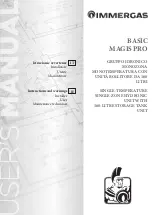
4-3
MAINTENANCE
SL 20-115 MODULATING GAS BOILER
4.1.11 Freeze Protection
Check freeze protection. Use only antifreeze made specifically for hydronic
systems. inhibited propylene glycol is recommended. antifreeze volume must not
exceed 50% of the total volume of water in the system.
4.1.12 boiler Treatment
•
Check consistency of any boiler treatment used, for appropriate mixture.
Chemical inhibitors are consumed over time, lowering their density.
•
Verify proper operation after servicing.
4.1.13 Relief valve - Maintenance and Testing
the relief valve manufacturer requires that under normal operating conditions
a “try lever test” must be performed every two months. under severe service
conditions, or if corrosion and/or deposits are noticed within the valve body,
testing must be performed more often. a “try lever test” must also be performed
at the end of any non-service period.
test at or near maximum operating pressure by holding the test lever fully open
for at least 5 seconds to flush the valve seat free of sediment and debris. Then
release the lever and permit the valve to snap shut.
if the lever does not activate, or there is not evidence of discharge, discontinue
use of equipment immediately and contact a licensed contractor or qualified
service personnel.
If the relief valve does not completely seal, and fluid continues to leak from the
discharge pipe - perform the test again to try and flush any debris that may be
lodged in the valve. if repeated tries fail to stop the leakage, contact a licensed
contractor or qualified service personnel to replace the valve.
While performing a “try lever test”, a quantity of heat transfer fluid will be
discharged from the piping system and the system pressure will drop. This fluid
must be replaced. it is highly recommended that a system pressurization unit,
such as an
Axiom Industries model MF200
be employed to refill and pressurize
your system. Capture the discharged fluid in a container and recycle it by
returning it to the system feeder unit. this is particularly important when your
system contains treatment chemicals or glycol solutions. if the system employs
plain water, the boiler auto fill valve must be turned on in order to recharge the
lost fluid.
CAUTION
Before testing the relief valve,
make certain the discharge
pipe is properly connected to
the valve outlet and arranged
to contain and safely dispose
of equipment discharge.
NOTE
Installers should inquire of
local water purveyors as to
the suitability of their supply
for use in hydronic heating
systems.
If water quality is questionable,
a local water treatment expert
must be consulted for testing,
assessment and, if required,
treatment.
Alternatively, water or hydronic
fluid of known quality can be
brought to the site.
WARNING
Do not use automotive-type
ethylene or other types of
automotive glycol antifreeze,
or undiluted antifreeze of
any kind. This may result
in severe boiler damage. It
is the responsibility of the
Installer to ensure that glycol
solutions are formulated to
inhibit corrosion in hydronic
heating systems of mixed
materials. Improper mixtures
and chemical additives may
cause damage to ferrous and
non-ferrous components as
well as non-metallic, wetted
components, normally found
in hydronic systems. Ethylene
glycol is toxic, and may be
prohibited for use by codes
applicable to your installation
location. For environmental
and toxicity reasons, IBC
recommends only using non-
toxic propylene glycol.
















































